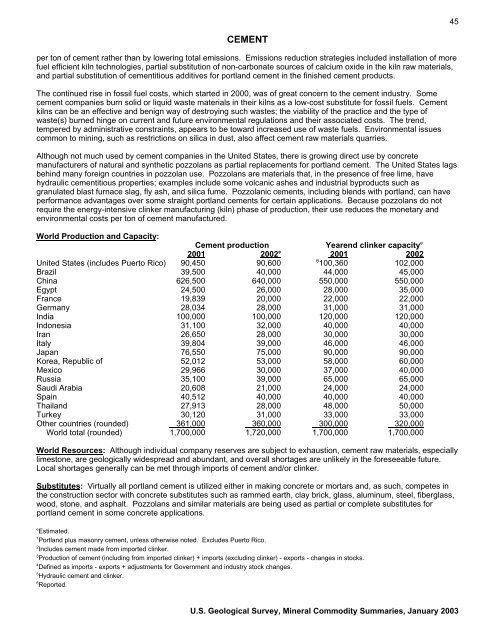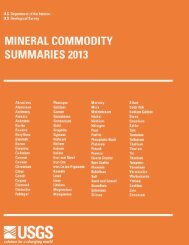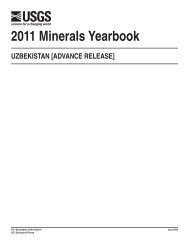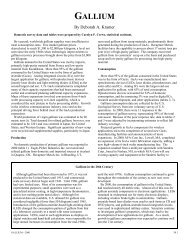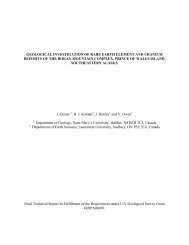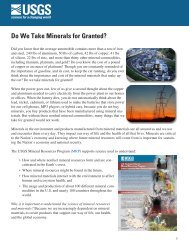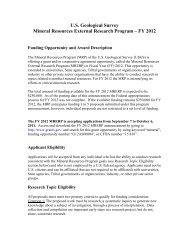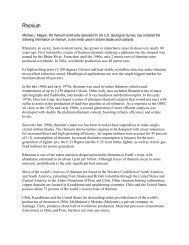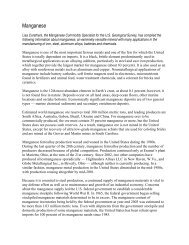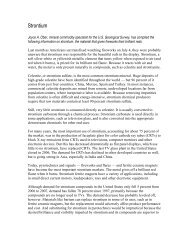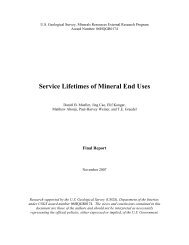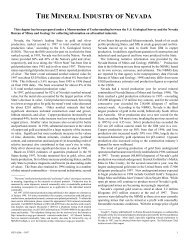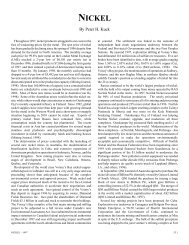Mineral Commodity Summaries 2003 - Mineral Resources Program ...
Mineral Commodity Summaries 2003 - Mineral Resources Program ...
Mineral Commodity Summaries 2003 - Mineral Resources Program ...
You also want an ePaper? Increase the reach of your titles
YUMPU automatically turns print PDFs into web optimized ePapers that Google loves.
CEMENT<br />
per ton of cement rather than by lowering total emissions. Emissions reduction strategies included installation of more<br />
fuel efficient kiln technologies, partial substitution of non-carbonate sources of calcium oxide in the kiln raw materials,<br />
and partial substitution of cementitious additives for portland cement in the finished cement products.<br />
The continued rise in fossil fuel costs, which started in 2000, was of great concern to the cement industry. Some<br />
cement companies burn solid or liquid waste materials in their kilns as a low-cost substitute for fossil fuels. Cement<br />
kilns can be an effective and benign way of destroying such wastes; the viability of the practice and the type of<br />
waste(s) burned hinge on current and future environmental regulations and their associated costs. The trend,<br />
tempered by administrative constraints, appears to be toward increased use of waste fuels. Environmental issues<br />
common to mining, such as restrictions on silica in dust, also affect cement raw materials quarries.<br />
Although not much used by cement companies in the United States, there is growing direct use by concrete<br />
manufacturers of natural and synthetic pozzolans as partial replacements for portland cement. The United States lags<br />
behind many foreign countries in pozzolan use. Pozzolans are materials that, in the presence of free lime, have<br />
hydraulic cementitious properties; examples include some volcanic ashes and industrial byproducts such as<br />
granulated blast furnace slag, fly ash, and silica fume. Pozzolanic cements, including blends with portland, can have<br />
performance advantages over some straight portland cements for certain applications. Because pozzolans do not<br />
require the energy-intensive clinker manufacturing (kiln) phase of production, their use reduces the monetary and<br />
environmental costs per ton of cement manufactured.<br />
World Production and Capacity:<br />
Cement production Yearend clinker capacity e<br />
2001 2002 e<br />
2001 2002<br />
United States (includes Puerto Rico) 90,450 90,600<br />
6<br />
100,360 102,000<br />
Brazil 39,500 40,000 44,000 45,000<br />
China 626,500 640,000 550,000 550,000<br />
Egypt 24,500 26,000 28,000 35,000<br />
France 19,839 20,000 22,000 22,000<br />
Germany 28,034 28,000 31,000 31,000<br />
India 100,000 100,000 120,000 120,000<br />
Indonesia 31,100 32,000 40,000 40,000<br />
Iran 26,650 28,000 30,000 30,000<br />
Italy 39,804 39,000 46,000 46,000<br />
Japan 76,550 75,000 90,000 90,000<br />
Korea, Republic of 52,012 53,000 58,000 60,000<br />
Mexico 29,966 30,000 37,000 40,000<br />
Russia 35,100 39,000 65,000 65,000<br />
Saudi Arabia 20,608 21,000 24,000 24,000<br />
Spain 40,512 40,000 40,000 40,000<br />
Thailand 27,913 28,000 48,000 50,000<br />
Turkey 30,120 31,000 33,000 33,000<br />
Other countries (rounded) 361,000 360,000 300,000 320,000<br />
World total (rounded) 1,700,000 1,720,000 1,700,000 1,700,000<br />
World <strong>Resources</strong>: Although individual company reserves are subject to exhaustion, cement raw materials, especially<br />
limestone, are geologically widespread and abundant, and overall shortages are unlikely in the foreseeable future.<br />
Local shortages generally can be met through imports of cement and/or clinker.<br />
Substitutes: Virtually all portland cement is utilized either in making concrete or mortars and, as such, competes in<br />
the construction sector with concrete substitutes such as rammed earth, clay brick, glass, aluminum, steel, fiberglass,<br />
wood, stone, and asphalt. Pozzolans and similar materials are being used as partial or complete substitutes for<br />
portland cement in some concrete applications.<br />
e<br />
Estimated.<br />
1<br />
Portland plus masonry cement, unless otherwise noted. Excludes Puerto Rico.<br />
2<br />
Includes cement made from imported clinker.<br />
3<br />
Production of cement (including from imported clinker) + imports (excluding clinker) - exports - changes in stocks.<br />
4 Defined as imports - exports + adjustments for Government and industry stock changes.<br />
5 Hydraulic cement and clinker.<br />
6 Reported.<br />
U.S. Geological Survey, <strong>Mineral</strong> <strong>Commodity</strong> <strong>Summaries</strong>, January <strong>2003</strong><br />
45


